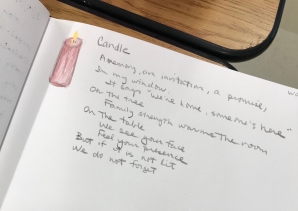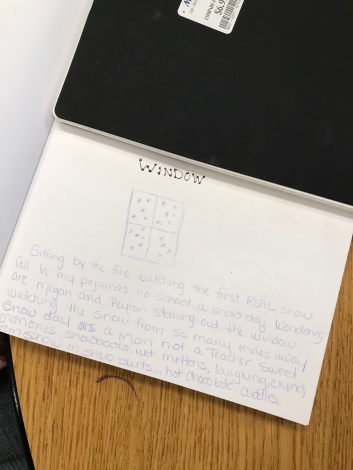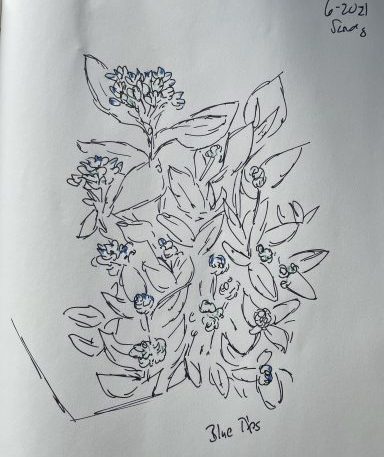“The process of discovery inspires a sense of wonder.” Donald Graves, Bring Life into Learning
It was twenty something years ago that I sat in a classroom at the University of New Hampshire with Maureen Barbieri. I had signed up to participate in their summer writing institute for teachers. New to teaching, new to writing, I was nervous and scared. But I went. Adding to my nerves and uncertainty, was the fact that I missed the first day due to a car accident. But still, I went. (Thanks to my then boyfriend, now husband, for driving me all the way to UNH the next day)
With the gentle guidance of Maureen, and being surrounded by others there to write, I began to see myself as a writer. I was allowed to draw and play with words to create a simple poem about my mother. Maureen created an environment in that classroom and in her home (yes, she invited us to her home and I remember playing with gouache paint which the next day led to more writing) that supported exploration for the writers before her.
There has been a recent call for low stakes writing in classrooms. Ralph Fletcher and his book Joy Write, got us all thinking about how we could create time and space for young writers to play with words and ideas, “an environment where young writers can flourish, have fun, produce both quantity and quality, and discover for themselves”.
Ever since reading Joy Write, I’ve had the opportunity to work with teachers in their classrooms to create a structure that supports low stakes writing, much like Maureen created for me twenty something years ago. I’ve written about the discoveries from this research question here on this blog many times. The work in these classrooms has been a source of inspiration for me as a teacher researcher and a teacher writer.
This past Friday, my district had a PD day. The day, Westport Learns, was a day of workshops led by colleagues within the district. A day where we could learn from and with each other. A fourth grade teacher, friend, and colleague, Jessica Marino, and I planned to run a workshop to share what call Journal Soft Start. A time where her fourth graders are engaged and discovering themselves as writers in a low stakes environment.
So, Friday morning, I found myself, alongside Jessica, sitting in a room with five other educators who were curious about the possible role of a Journal Soft in their own classrooms. Rather than present a series of slides describing the ins and outs of Journal Soft Start, Jessica Marino and I structured our workshop so that teachers could experience the parts of a Journal Soft Start themselves. A Piaget approach to teaching teachers – learn by doing, learn from experience.
We walked them through the structure of Journal Soft Start – a quick whole class experience rooted in the habits of a writer (writers observe, writers play, writers copy to think, writers observe, etc) followed by Invitations. The Invitations are meant to literally invite and inspire each writer to think and play with their own ideas.
We shared the most popular and powerful Invitations – Word of the Day #DWHabit, Copying an Art Card, Observing an Object, and even a Slice of Life. After the explanation of each Invitation, we gave them time to experience that invitation for themselves and then we shared.
I watched as Joyce wrote. I listened as she bravely shared her piece. Smooth and calmly she read her slice and as she neared the end, you could hear the hesitation and quiver in her voice and suddenly, she handed her journal to Jessica, and Jessica read the last few lines.

I watched as Kristen wrote. She bravely shared first. Confidently and lovingly she shared her piece about her cat. At the end, like Joyce, her voice cracked and her eyes welled up.

I watched as Michele drew and wrote across from me. I listened as she shared her first slice of life. The slice moved slowly at first building anticipation for the reader. It began, “My daughter baked a cake.” It led the reader to think this moment in time was going to take a turn for the worse but no, we her audience, had smiles on our faces as she read “the first slice revealed all these blue candies coming out. I am going to be a grandma.”
Becky had chosen the WOTD, WINDOW to inspire her writing. She wrote of snow days as a mom, not as a teacher. Her writing brought a sweet pause over our group as we, too, remembered alongside her.

Writing evokes emotion. It has the power to connect us to our stories and our emotions, which is a priceless connection in a day and age when many seem numb to their own emotions and stories.
I watched Becky, Kristen, Joyce, Lynn, and Michelle repeatedly put pen to paper, pick up the oil pastel and draw and sketch to think throughout our workshop. I watched and I realized that if teachers are to implement low stakes writing then they need to understand and experience it for themselves.
We teacher writers need to take our colleagues under our wings and work together to create a softly structured time that supports low stakes writing and develops the habits and mindset that writers need to live the life of a writer. Low stakes writing can be so much more than simply putting it up as a choice for morning work. A little personal experience, structure and choice can go a long way in creating an environment that supports low stakes writing for all ages.
Finally, I believe that this environment of writing as discovery and low stakes can contribute to a tighter classroom community, even a tighter school community. It is in this type of environment that writers have time to find the voice for their own stories. In sharing those stories, we not only write, we get to know each other.



You are inspiring so many teacher writers by sharing your own experiences and your own questions and your own passions.
LikeLiked by 1 person
You hit it out of the park, AGAIN, Dawn! I’m so glad the #DWHabit WOTD continues to inspire you, your students, and other teacher-writers. I’d like to add this post to next week’s Writing Round-Up too. Such goodness here that needs to be shared.
LikeLiked by 3 people
I am honored to have witnessed the power of WOTD, visual literacy, choice and time to write for writers of all ages! It is awesome!
LikeLike
This is a beautiful post! Thank you for sharing this, Dawn! I am so inspired!!!
LikeLiked by 1 person
I dream of having teachers write beside me! This is wonderful. I especially like the candle one. Such raw emotion. Thank you for sharing.
LikeLiked by 1 person
I dream of writing with colleagues, too, Leigh Anne. So glad I have my Teach Write and TWT soul mates.
LikeLiked by 1 person
Such good stuff! So many great things happen when we open ourselves up and help others to do the same. Next year, back to back sessions!!!
LikeLiked by 1 person
add that to the “list” of things to guide us next year!! 😉
LikeLike
So encouraging! At the time when so much is focused on writing to pass a test or exam, you bring the JOY back to writing!
LikeLiked by 1 person
There is so much to be said for a calm, warm environment.
Stop, slow down, take a breath and then this magic . . .
“We teacher writers need to take our colleagues under our wings and work together to create a softly structured time that supports low stakes writing and develops the habits and mindset that writers need to live the life of a writer. ”
🙂
LikeLiked by 1 person
You helped start this in my classroom last year and now it has become one of my favorite times in my classroom. My students and I call it ‘Writer’s Meeting.’ I think it is when all of us are just ourselves, because our writing is taking us to where we need to be.
LikeLiked by 1 person
So gorgeous, Dawn. I loved reading about this special day from both you and Jen. What a treasure to have this time together and colleagues to share it with. Envious.
LikeLiked by 1 person
OK, I really love this idea! You had me remembering experiences I’ve had at workshops where I was allowed to write in my journal and play with words. We need more of this in schools. I’m going to find a way to do this with my teachers. Thanks for sharing. Beautifully written piece!
LikeLike